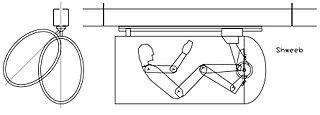Shweeb
This article needs additional citations for verification. (September 2015) |

Shweeb is a proposed personal rapid transit network based on human-powered monorail cars. The project prototype was originally designed and implemented in Rotorua, New Zealand as a leisure attraction. 38°05′25″S 176°11′43″E / 38.0902°S 176.1952°E. In September, 2010, a proposal for development of an expanded network was chosen to receive funding from Google as part of project 10100.[1] As of April 2012, the system has not been considered by anyone with the ability to implement it.[citation needed].
A North American company says it will install a Shweeb system at the "world's first eco-friendly amusement park" in Niagara Falls, Canada; their website says it will open in 2015.[2][needs update]
The proposed Shweeb transit network relies on recumbent bicycle technology to power pods suspended from monorails. According to Shweeb Monorail Technology, the intent of their proposal is to "create a solution which provided the user with the same flexibility and comfort offered by the car but without the consequential costs - both direct financial and indirect health and environmental costs."[3] The proposal envisions networks of monorail track providing point to point and commuter transit for urban areas.
Technical
Track
The track is built in folded galvanised steel. Its external height is 220mm x width 200 mm. Support piles are also in galvanised steel.
Pods
Pods are covered with transparent plastic sheets, with ventilation holes. Front and rear long dampers are provided to limit the impact acceleration in case of pods collision and to ease the association of pods to build 'pod trains' which could significantly improve overall aerodynamic efficiency.
External power boost
To help climb ramps, an electrically powered chain installed on a track section could push the pods for a limited distance, in a way similar to the Trampe bicycle lift. This could also help entering stations built at a higher elevation than the track. The purpose of this elevation is to help a pod gaining momentum while descending from station track to the main line track.
See also
References
- ^ "Project 10 to the 100 - Idea: Drive innovation in public transport". Google. October 2011. Retrieved July 16, 2012.
- ^ "SHWEEB Eco-Ventures Park Coming to Niagara Falls, Ontario Canada in 2015". Retrieved November 1, 2013.
- ^ Jack Martin (July 23, 2008). "The Shweeb Human-powered monorail". GizMag. Retrieved July 16, 2012.
External links
- Official Shweeb Internet site Including pictures and videos of the Shweeb attraction device
- Shweeb-Can Corporation North American website, includes CG images of Shweeb PRT network
- Film of Rotorua system
- Skyride, a similar system
